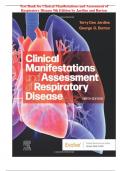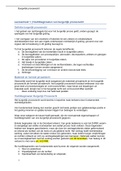Test Bank for Clinical Manifestations and Assessment of
Respiratory Disease 9th Edition by Jardins and Burton
,Chapter 01: The Patient Interview
Des Jardins: Clinical Manifestations and Assessment of Respiratory Disease, 9th
Edition
MULTIPLE CHOICE
1. The respiratory care practitioner is conducting a client interview. The main purpose of this
interview is to:
a. review data with the client.
b. gather subjective data from the client.
c. gather objective data from the client.
d. fill out the history form or checklist.
CORRECT ANSWER->>>>> B
The interview is a meeting between the respiratory care practitioner and the client. It allows the
collection of subjective data about the client’s feelings regarding his/her
condition. The history should be done before the interview. Although data can be reviewed,
that is not the primary purpose of the interview.
2. For there to be a successful interview, the respiratory therapist must:
a. provide leading questions to guide the client.
b. reassure the client.
c. be an active listener.
d. use medical terminology to show knowledge of the subject matter.
CORRECT ANSWER->>>>> C
U S N T O
The personal qualities that a respiratory therapist must have to conduct a successful interview include
being an active listener, having a genuine concern for the client, and having empathy. Leading
questions must be avoided. Reassurance may provide a false sense of comfort to the client. Medical
jargon can sound exclusionary and paternalistic to a client.
3. Which of the following would be found on a history form?
1. Age
2. Chief complaint
3. Present health
4. Family history
5. Health insurance provider
a. 1, 4
b. 2, 3
c. 3, 4, 5
d. 1, 2, 3, 4
CORRECT ANSWER->>>>> D
Age, chief complaint, present health, and family history are typically found on a health history
form because each can impact the client’s health. Health insurance provider information, while
needed for billing purposes, would not be found on the history form.
, 4. External factors the respiratory care practitioner should make efforts to provide during an
interview include which of the following?
1. Minimize or prevent interruptions.
2. Ensure privacy during discussions.
3. Interviewer is the same sex as the client to prevent bias.
4. Be comfortable for the client and interviewer.
a. 1, 4
b. 2, 3
c. 1, 2, 4
d. 2, 3, 4
CORRECT ANSWER->>>>> C
External factors, such as a good physical setting, enhance the interviewing process. Regardless of the
interview setting (the client’s bedside, a crowded emergency room, an office in the hospital or clinic,
or the client’s home), efforts should be made to (1) ensure privacy, (2) prevent interruptions, and (3)
secure a comfortable physical environment (e.g., comfortable room temperature, sufficient lighting,
absence of noise). An interviewer of either gender, who acts professionally, should be able to
interview a client of either gender.
5. The respiratory therapist is conducting a client interview. The therapist chooses to use
open-ended questions. Open-ended questions allow the therapist to do which of the
following?
1. Gather information when a client introduces a new topic.
2. Introduce a new subject area.
3. Begin the interview process.
4. Gather specific information.
a. 4 BBN
b. 1, 3
c. 1, 2, 3
d. 2, 3, 4
CORREC
T
ANSWE
R->>>>>
C
An open-ended question should be used to start the interview, introduce a new section of questions,
and gather more information from a client’s topic. Closed or direct questions are used to gather
specific information.
6. The direct question interview format is used to:
1. speed up the interview.
2. let the client fully explain his/her situation.
3. help the respiratory therapist show empathy.
4. gather specific information.
a. 1, 4
b. 2, 3
c. 3, 4
d. 1, 2, 3
CORRECT ANSWER->>>>> A
Direct or closed questions are best to gather specific information and speed up the interview. Open-
ended questions are best suited to let the client fully explain his/her situation and possibly help the
respiratory therapist show empathy.
, 7. During the interview the client states, “Every time I climb the stairs I have to stop to catch
my breath.” Hearing this, the respiratory therapist replies, “So, it sounds like you get short
of breath climbing stairs.” This interviewing technique is called:
a. clarification.
b. modeling.
c. empathy.
d. reflection.
CORRECT ANSWER->>>>> D
With reflection, part of the client’s statement is repeated. This lets the client know that what he/she
said was heard. It also encourages the client to elaborate on the topic.
Clarification, modeling, and empathy are other communication techniques.
8. The respiratory therapist may choose to use the client interview technique of silence
in which of the following situations?
a. To prompt the client to ask a question
b. After a direct question
c. After an open-ended question
d. To allow the client to review his/her history
CORRECT ANSWER->>>>> C
After a client has answered an open-ended question, the respiratory therapist should pause (use
silence) before asking the next question. This pause allows the client to add something else before
moving on. The client may also choose to ask a question.
9. To have the most productive interviewing session, which of the following types of responses
N URld tI
to assist in the interview shou SheGrNB.C
espTiratory tOherapist avoid?
a. Confrontation
b. Reflection
c. Facilitation
d. Distancing
CORRECT ANSWER->>>>> D
With confrontation, the respiratory therapist focuses the client’s attention on an action, feeling, or
statement made by the client. This may prompt a further discussion. Reflection helps the client
focus on specific areas and continues in his/her own way. Facilitation encourages clients to say
more, to continue with the story. The respiratory therapist should avoid giving advice, using
avoidance language, and using distancing language.
10. When closing the interview, the respiratory therapist should do which of the following?
1. Recheck the client’s vital signs.
2. Thank the client.
3. Ask if the client has any questions.
4. Close the door behind himself/herself for client privacy.
a. 2
b. 2, 3
c. 1, 3, 4
d. 1, 2, 4 CORRECT ANSWER->>>>> B





